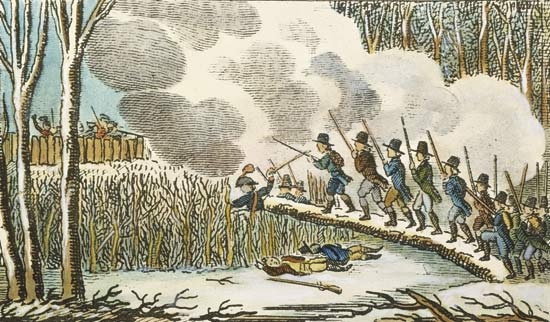King Philip's War
British-American Indian conflict
 (1675–76), in British-American colonial history, war between Native Americans (Native American) and English settlers, the bloodiest conflict in 17th-century New England, temporarily devastating the frontier communities but eventually eradicating native military resistance to the European colonization of that region. For years, mutual helpfulness and trade were fostered by both the early Massachusetts colonists and the Indian leader Massasoit, grand sachem of the Wampanoags. The peace was first shattered by the Pequot War in 1637. By the 1660s settlers had outgrown their dependence on the Indians for wilderness survival techniques and had substituted fishing and commerce for the earlier lucrative fur trade. From 1640 to 1675 new waves of land-hungry settlers pushed into Indian territory, particularly in Massachusetts, Connecticut, and Rhode Island. Tribes had to fight to protect their homelands; otherwise they would become “white men's vassals,” subject to alien law, humiliating limitations on personal freedom, usurpation of favourite hunting grounds, and regulation by a strict Christian morality.
(1675–76), in British-American colonial history, war between Native Americans (Native American) and English settlers, the bloodiest conflict in 17th-century New England, temporarily devastating the frontier communities but eventually eradicating native military resistance to the European colonization of that region. For years, mutual helpfulness and trade were fostered by both the early Massachusetts colonists and the Indian leader Massasoit, grand sachem of the Wampanoags. The peace was first shattered by the Pequot War in 1637. By the 1660s settlers had outgrown their dependence on the Indians for wilderness survival techniques and had substituted fishing and commerce for the earlier lucrative fur trade. From 1640 to 1675 new waves of land-hungry settlers pushed into Indian territory, particularly in Massachusetts, Connecticut, and Rhode Island. Tribes had to fight to protect their homelands; otherwise they would become “white men's vassals,” subject to alien law, humiliating limitations on personal freedom, usurpation of favourite hunting grounds, and regulation by a strict Christian morality.Upon Massasoit's death (1661) his successor and second son, Metacom (King Philip), vowed to resist further English expansion and attempted to organize a federation of tribes; eventually Metacom won support from the powerful Narragansett and almost all of the other New England tribes. When three Wampanoags were executed (June 1675) for the murder of an informer, John Sassamon, Metacom could no longer hold his young warriors in check, and bloodshed erupted before either side could coordinate campaign plans. The war actually resolved itself into a series of ruthless Indian raids on frontier settlements from the Connecticut River to Massachusetts and Narragansett Bay, followed by brutal retaliatory assaults on Indian villages by the colonial militia. By the end of 1675 many frontier towns had been devastated, and the Narragansett had been wiped out in what was called the Great Swamp Fight. The Indians maintained a distinct advantage in the fighting until the spring of 1676, when their efforts were undermined by the threat of starvation after the destruction of their crops and when the English finally agreed to use “Praying Indians” (those who had converted to Christianity) as scouts. Following Metacom's death in August, Indian resistance collapsed, although Articles of Peace were not signed for two years.
King Philip's War was one of the costliest confrontations in colonial history: Edward Randolph, an agent of the crown, estimated that some 600 Europeans and 3,000 Indians lost their lives. It is believed that more than half of the 90 settlements in the region had been attacked and a dozen destroyed. Whole Indian villages were massacred and entire tribes decimated; indigenous refugees fled westward and northward. Thereafter settlers felt free to expand without fear into former Indian territory across southern New England.
- Prudentius
- Prudhoe Bay
- Prud'hon, Pierre-Paul
- prune
- pruning
- Prunus
- Prus, Bolesław
- Prusiner, Stanley B.
- Prussia
- Prussian blue
- Prussian Civil Code
- Prut River
- Pryluky
- Prynne, William
- Pryor
- Pryor, Richard
- prytaneum
- Przemyśl
- Przewalski's horse
- Przhevalsky, Nikolay Mikhaylovich
- Przyboś, Julian
- Przybyszewski, Stanisław
- Przysucha, Jacob Isaac ben Asher
- Práxedes Mateo Sagasta
- Préfecture de Police